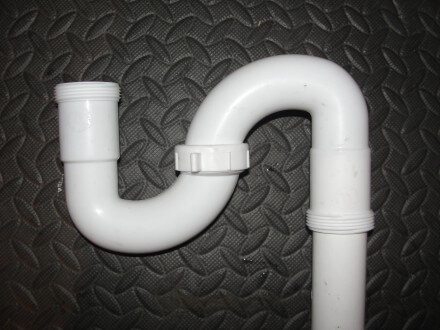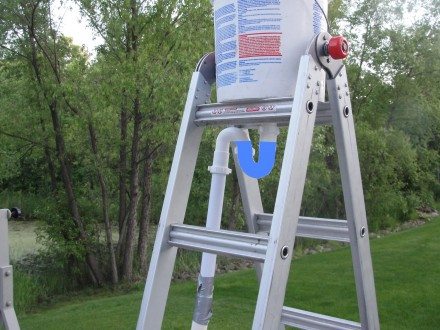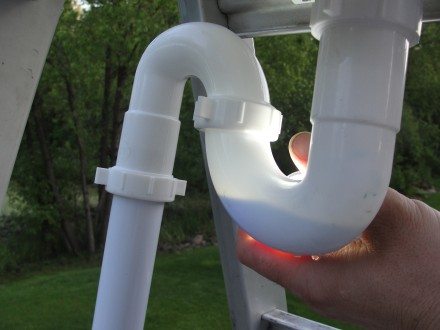A common plumbing defect found in many older houses is an “S” trap. An “S” trap is named so because it looks like an “S” on its side – it basically consists of a normal trap, and then another trap installed right up against it in an upside-down fashion, as shown below. These traps are prohibited by the Minnesota State Plumbing Code, but that doesn’t mean you can’t buy them at any home improvement store.
The most common places you’ll find “S” traps are at plumbing fixtures that aren’t vented, such as an illegal basement bathroom sink, a DIY basement bar sink, or a kitchen sink where the old steel drain in the wall was so corroded and blocked that someone installed a new drain, but never bothered to vent it.
The purpose of a trap is to prevent sewer gases, and possibly vermin, from coming in to the home. When water sits in the trap, sewer gases stay out. Have you ever noticed some nasty odors in a bathroom that you never use? It’s probably because the water in the trap has completely evaporated, allowing sewer gases to come in to the home. I’ve actually found this condition on a number of larger occupied houses. The easiest fix for this is to periodically run a little water in the plumbing fixtures. As a longer-term solution, you could also pour RV antifreeze in to the drains; that stuff won’t evaporate.
Back to “S” traps – The reason “S” traps aren’t allowed is because they have the potential to suck, or ‘siphon’, water out of the trap as the water flows down the drain. On a properly installed “P” trap, there is a vent at the same place the drain turns downwards, which breaks the siphon. In other words, the vent prevents water from getting sucked out of the trap. How much water can get sucked out of the trap? Believe it or not, enough water to break the water seal at the trap and let sewer gases come in to the house.
To show how this works, I set up a little rig in my back yard to show how much water can get siphoned out of an “S” trap. I forgot to take a close-up before photo, so I marked up this photo below with blue to show where there was standing water in the trap. The top of the water level is called the ‘weir’ of the trap.
As I let the water in the 5-gallon bucket drain out, most of the water in the trap ended up getting siphoned out. I added some food coloring to the water and held my flashlight up against the back of the trap to show this.
To see how this happens, here’s a quick video I took during a home inspection. Listen to the gurgling noise at the very end of the water draining – this gurgling sound is a dead giveaway that a plumbing fixture isn’t properly vented.
There’s usually no simple way to properly correct an “S” trap. It’s usually an involved, expensive repair. On the other hand, when water is flowing in to a sink from the faucet, there’s usually not enough water draining at one time to create this siphon action, so “S” traps typically don’t cause any big problems. Problems occur when the sink is filled with water and then drained. Even then, the simple way of dealing with this is to just run a little extra water down the drain after the water has drained out. This will re-fill, or ‘prime’, the trap after the water has been siphoned out… this is the same way toilets work.
In other words, “S” traps are wrong, but they’re not that big of a deal.
Reuben Saltzman, Structure Tech Home Inspections – Email – Minnesota Home Inspections








mark
July 2, 2012, 9:23 am
I liked your report on S traps. There are quite a few homes that have these. I would recommend venting the fixture properly. Homes in MPLS will need to have these corrected for sale purposes. Great report Reuben.
Illegal Plumbing Products in Minnesota | Structure Tech Home Inspections
November 20, 2012, 5:05 am
[…] ambitious-looking square on the cover has decided to be, unfortunately. He’s installing an S-trap, which is illegal in Minnesota (4715.0960), and as far as I know, everywhere else in the country. […]
Plumbing Vents, Why Houses Need Them (forget the soda bottle analogy) | Structure Tech Home Inspections
January 29, 2013, 9:14 am
[…] effect, which has the potential to pull water right out of the plumbing trap. In my blog about S-traps, I included a quick video clip of an unvented drain having water siphoned out of it, leaving the […]
Ed Mitchell
April 14, 2013, 3:42 am
Excellent description on how an S-trap works. It is explained in simple form so an average person can understand. Great job.
Drum Traps | Structure Tech Home Inspections
April 16, 2013, 3:47 am
[…] my posts about s-traps and plumbing vents, I explained how proper plumbing vents prevent water from getting siphoned out […]
Regina
July 29, 2013, 7:33 am
S trap explanation great, also RV antifreeze suggestion. My problem is that AC unit pulls out water from bathtub trap and washing machine emergency floor drain. Could they be “S” trap problems? I keep filling drains, but 3T unit pulls out water within 1 hour.
Reuben Saltzman
July 29, 2013, 2:19 pm
Hi Regina, I don’t understand how your AC could pull water out from any of the traps, no matter what type of traps they are. I don’t think the liberty pump has anything to do with it either.
Regina
July 29, 2013, 7:38 am
Also have Liberty pumb in basement to pump out water from toilet, sink, washer and slop sink. It is connected directly to main sewer line. When it discharges could it siphon out water from entire system?
Doug
November 10, 2013, 8:34 pm
Thanks for the well done article on S-traps. My master bath vanity has an S that looks like a complete loop. It does go dry at times, releasing odors into my bedroom. Also no vent pipe either – the drain goes through the floor, not into the wall.
I want to switch to a P-trap with an air admittance valve added at the end. Is it ok if the pipe at the down steam end of the P is curved around horizontally to line up with the existing hole in the floor that is almost directly below the sink drain – or does it have to be straight, meaning a new hole in the floor further away? Thanks.
Reuben Saltzman
November 11, 2013, 4:38 am
Hi Doug, it’s OK if the pipe curves horizontally downstream from the air admittance valve.
How to Finish a Basement Bathroom - Part 2
December 22, 2013, 1:07 pm
[…] a P-trap below grade because there’s hardly any room here for a P-trap. There is room for an S-trap but those are illegal per the Building Code and will siphon water allowing sewer gases to rise out of the drain. (Update: After finishing the […]
Doug
December 29, 2013, 2:28 pm
I’m having a problem with my basement bathroom traps getting sucked dry when my sewage pump kicks on. There is a toilet , sink , and shower. The sink and shower traps get to low of water when the pump kicks on to discharge and then I will get the sewage smell. The toilet will not go dry but the water level is lowered. Also there is some gurgling sound in shoer drain when this happens. What could be the problem? Thx
Reuben Saltzman
December 29, 2013, 3:55 pm
@Doug – your sewage pit isn’t vented.
Doug
December 29, 2013, 7:50 pm
Thanks Reuben I figured it out. It is vented but the plumber failed to cut the cap off the vent on the roof. After getting on the the roof to check the vent I figured this out.